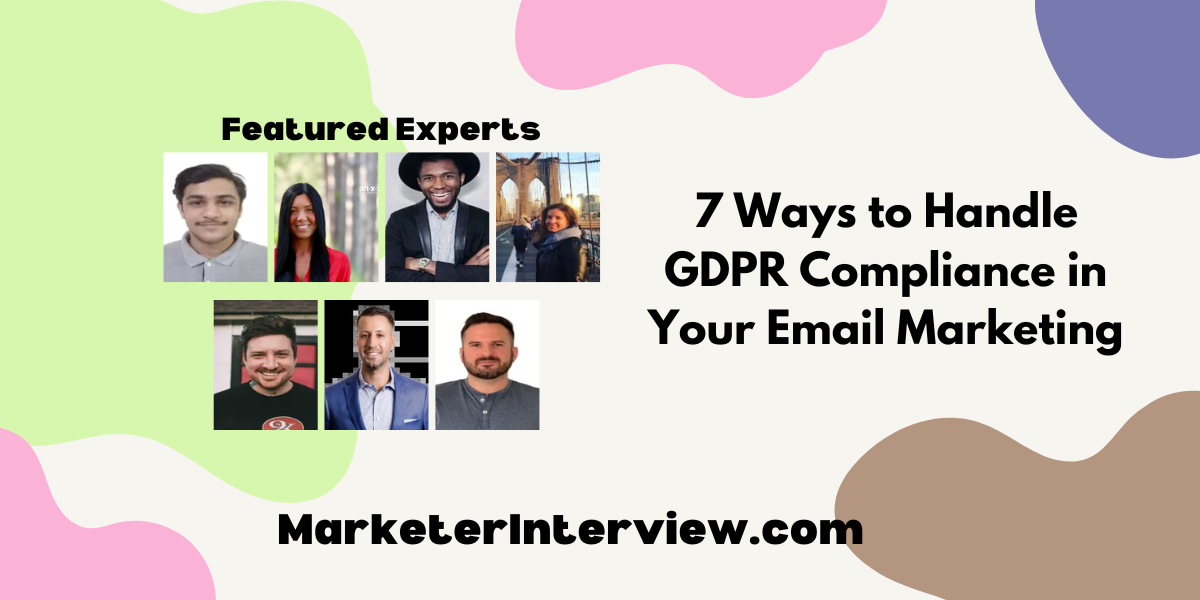7 Ways to Handle GDPR Compliance in Your Email Marketing
Navigating GDPR compliance in email marketing can be complex, so we’ve gathered seven expert tips from CEOs and marketing managers to guide you. From focusing on data minimization to adopting a double opt-in subscription process, these insights will help you stay compliant and respect subscriber privacy.
Want to get quoted in MarketerInterview.com content just like this? Apply to become a contributor today!
Contents
Focus on Data Minimization
We make GDPR compliance a priority by focusing on data minimization. We only collect the information we absolutely need from subscribers, and avoid optional fields when possible. Before launching any email campaign, we double-check that we have specific consent for how we plan to use the data. If consent seems unclear, we delete those subscribers to avoid issues.
We also invest heavily in data security and employee education. Our team completes GDPR training twice annually to stay up to date with regulations. We routinely test our data breach response plan through simulations. Within the last year, we identified and resolved a vulnerability that could have exposed contact details. Resolving it quickly was key to our compliance.
Transparency builds trust. Our privacy policy clearly explains how we use data, and we include summaries in our signup forms and email footers. Subscribers can update preferences or unsubscribe at any time through our preference center. We make unsubscribing as easy as subscribing to give users control over their data. Compliance is an ongoing effort, but focusing on fundamentals like these helps minimize risk.

Nicole Farber, CEO, ENX2 Legal Marketing
Ensure Express Subscriber Consent
We strongly value our subscribers’ privacy.
A vital piece of advice for email marketers looking to comply with GDPR is to make sure you have your subscribers’ express consent before sending them any emails.
This means setting up an opt-in procedure that is transparent and straightforward, in which users voluntarily choose to receive notifications from you.
Also, consider using the double opt-in strategy, which involves sending them an email to confirm their permission. Plus, make sure that your subscribers get an easy-to-find unsubscribe button in your emails.
Always ensure that your privacy policy describes how you handle personal data and is easily accessible.
Additionally, you have to maintain accurate consent records. This way, you can strengthen your compliance and build trust with your audience by honoring their right to privacy.

Gabriel Kaam, CEO, KNR Agency
Verify Data Source and Opt-Out Control
First of all, you have to be sure of your data (emails) sources. How did you get those emails? Did they agree to receive your marketing communications? Do you give them the opportunity to opt out in every communication piece you share? Your recipients have to have full control over what happens with their data. That’s the whole purpose of GDPR.

Anna Burtan, Content Marketing Manager, Leadfeeder
Classify Contacts for Marketing Compliance
One of the most significant challenges in scaling up a startup lies in establishing connectivity between the website, CRM system, and email platform. This integration is pivotal for effective inbound marketing strategies. But beyond technical integration, GDPR compliance mandates a crucial shift in how we handle data. It’s imperative that commercial teams classify incoming contacts as “marketable contacts” based on the criteria of your inbound platform.
This ensures that every new lead and prospect entering the ecosystem has provided consent for marketing communications. Without this foundational layer of consent, these contacts cannot be effectively nurtured through our marketing funnel. Sticking to these practices not only ensures GDPR compliance but also strengthens trust with the audience by respecting their privacy preferences.

Ryan Sullivan, Marketing Manager, Stay22
Obtain Explicit, Informed Subscriber Consent
One specific tip for handling GDPR compliance in your email marketing is to ensure that you obtain explicit, informed consent from your subscribers before sending them marketing emails. This practice not only aligns with GDPR requirements but also helps build trust and maintain a high-quality email list.
To implement this, start by using clear, concise language in your sign-up forms to explain what subscribers are consenting to. This includes specifying the type of content they will receive, how often they will receive emails, and what kind of data you will collect and how it will be used. Avoid using pre-ticked checkboxes or any form of implied consent. Instead, use unchecked boxes that require an affirmative action from the user to opt in.
When users sign up for your emails, send a confirmation email that requires them to click a link to verify their subscription (double opt-in). This step ensures that the subscriber is genuinely interested and consents to receive your communications. Additionally, maintain detailed records of when and how consent was obtained for each subscriber. This includes keeping logs of sign-up forms, the date and time of consent, and the specific version of the privacy policy that was agreed to.
Regularly review and update your privacy policy and communicate any changes to your subscribers. Make sure that your policy clearly explains their rights under GDPR, including how they can access, correct, or delete their personal data, and how they can withdraw consent at any time.
Lastly, always provide an easy and straightforward way for subscribers to opt out or unsubscribe from your email list. Include a visible and functional unsubscribe link in every email you send, and promptly honor all unsubscribe requests. This not only complies with GDPR but also helps maintain a positive relationship with your audience.
By obtaining explicit, informed consent and maintaining transparent, user-friendly practices, you can effectively manage GDPR compliance in your email marketing efforts, ensuring both legal compliance and a strong, trusting relationship with your subscribers.

John Reinesch, Founder, John Reinesch Consulting
Conduct Regular Email List Audits
I would recommend conducting regular audits of your email lists to ensure GDPR compliance. At my agency, we review our lists quarterly to confirm we have proper consent documentation for each subscriber. If we find any contacts with unclear permission, we either delete them or re-confirm consent.
Standardize your email sign-up and preference center processes. We use double opt-in for all new sign-ups, clearly stating how we use data and requesting consent. Make these forms easy to find on your site and in emails.
Educate your team on GDPR and privacy best practices. We have bi-weekly meetings to review new regulations and guidelines. Compliance is an ongoing effort, not a one-time training.
Test your data breach response plan. Have a process to identify, contain, and report incidents within 72 hours, as GDPR requires. Run drills to prepare for different scenarios and find any gaps. Data security and responsible breach management are key to compliance and trust.

Jeff McGeary, Founder & CEO, PracticeVIP LLC
Adopt Double Opt-In Subscription Process
Implement a double opt-in process.
Double opt-in means that after a user initially signs up to receive emails (single opt-in), they receive a confirmation email asking them to confirm their subscription by clicking a link or button. This extra step ensures that the person who signed up is the rightful owner of the email address and genuinely wants to receive emails from you.

Samanyu Marda, Marketing Intern, Mailmodo
Want to get quoted in MarketerInterview.com content just like this? Apply to become a contributor today!






